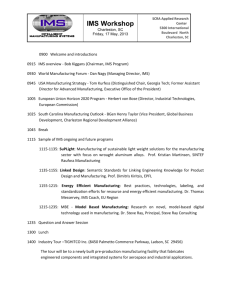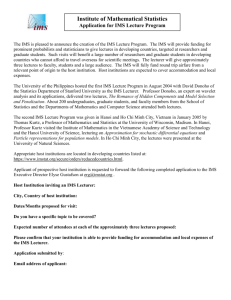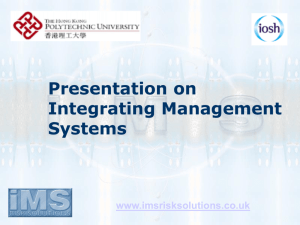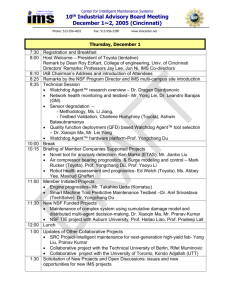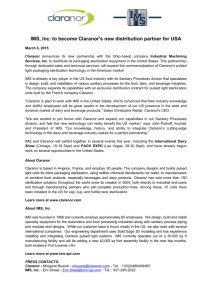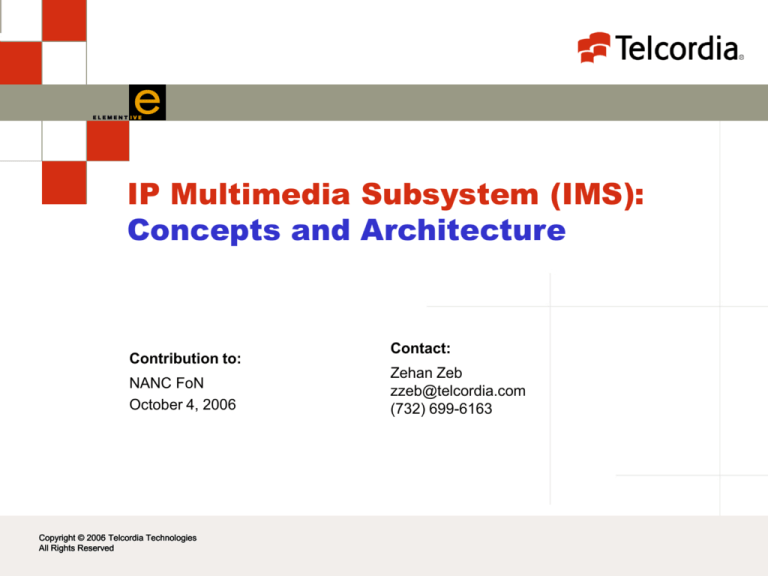
IP Multimedia Subsystem (IMS):
Concepts and Architecture
Contribution to:
NANC FoN
October 4, 2006
Copyright © 2006
2005 Telcordia Technologies
All Rights Reserved
Contact:
Zehan Zeb
zzeb@telcordia.com
(732) 699-6163
IMS Concepts and Architecture
Outline
IMS Concepts
–
Introductory concepts and IMS general
terminology
Functional
Entities and their Roles
Major nodes/entities
– Roles and functions provided
– Architecture associated with major functional
entities
–
Overall Architecture
Summary
2
IMS Concepts
How
Did We Arrive At IMS?
Definition of IMS
UE
User Identities
IP Connectivity Access Network (IP-CAN)
IP Multimedia Sessions
Transition to IMS Architecture
3
How did we arrive at IMS?
Technology Evolution
PSTN
Circuit switched
Analog
Digital
SS7
ISDN
Wireless
Circuit
Internet
switched
Analog
Digital
2G
IP
(GSM
& CDMA
ANSI-41)
3G Wireless
IMS
W-CDMA
–
VoIP
–
Instant Messaging
–
Web Applications
3G wireless + IP ++
–
Standard Services
Platform
–
Converged
Applications &
Content
–
Access
Independence
GPRS/UMTS
4
IMS Concepts
What is IMS?
IP
Multimedia Subsystem (IMS) is a Service
Delivery Architecture
• Standardized architecture to provide Internet
Protocol (IP)-based mobile and fixed multimedia
services
IMS
architecture has evolved over the past
few years
Today, IMS could allow operators who own
different types of networks with varying
architectures to offer the same services to all
of their customers
5
IMS Concepts
User Equipment (UE)
UE: A device that has IP connectivity and is
able to request an IP address from the
network
–
Examples: SIP phone, PC, PDA
UE
negotiates its QoS requirements and other
capabilities during a session setup
UE negotiates items, such as:
Media Type
– Direction of traffic
– Bit rate, packet size, bandwidth adaptation
–
6
IMS Concepts
IMS User Identification
An IMS user is allocated one or more Public User
Identities by the home operator
A Public User Identity is either a SIP URI or a TEL URL
–
–
–
–
When the Public User Identity contains a SIP URI, it
typically takes the form of sip:first.last@operator.com
When the Public User Identity contains a TEL URL
representing a phone number in international format it
typically takes the form of tel:+1-212-555-0293
It is possible to include a telephone number in a SIP URI
using the following format:
sip:+1-212-555-0293@operator.com;user=phone
TEL URLs are needed for inter-working with PSTN phones
In IMS, Public User Identities are used to route SIP
signaling
7
IMS Concepts
IMS User Identification (contd.)
Each IMS subscriber is assigned a Private User
Identity by the home operator
Unlike Public User Identities, Private User
Identities are not SIP URIs or TEL URLs
They take the format of a NAI (Network Access
Identifier)
– The format of a NAI is username@operator.com
–
Private
User Identities are exclusively used for
subscription identification and authentication
purposes
Private User Identities are not used for routing
SIP requests
8
Relationship Between User Identities
Sip:zehan.zeb@newstore.com
tel:+17324567888
zzeb@tmobile
.com
IMS
Subscriber
Private User Identity
Sip:zehan.zeb@example.com
tel:+88028112347
Public User Identities
9
IMS Concepts
3GPP IP-CAN
UE
IP-CAN
(GPRS
-based)
IMS
Nodes
RAN
SGSN
GGSN
•IMS network utilizes IP-CAN to transport
multimedia signaling and bearer traffic
•It is the network that connects the UE to the
IMS network
10
IMS Concepts
IP Multimedia Session (contd.)
UE1
IP-CAN
IMS
Session control signaling
IP-CAN
UE2
Media (data) Flow
•An IP Multimedia Session is comprised of session management control connections
and media flow connections between two or more users
•IMS users are able to mix and match a variety of IP-based services in a way they
choose during a single communication session
11
IMS Concepts- Transition
Public Land Mobile Network (PLMN)
HLR
SCP
MSC
Carrier A
GSM / ANSI Network
SS7/
ISUP
HLR
SCP
MSC
Carrier B
GSM / ANSI Network
12
IMS Concepts-Transition
IMS Architecture: High Level View
HSS
SIP
UE1
HSS
ASs
ASs
CSCFs
IMS Network
Carrier A
CSCFs
UE2
IMS Network
Carrier B
13
IMS Concepts-Transition
Interoperability: High Level View
HSS
SIP
UE
HSS
ASs
UE
ASs
CSCFs
CSCFs
Interworking
Functions
IMS Network
Carrier A
IMS Network
Carrier B
ISUP
SCP
ISPs
SSP
PSTN
14
Functional Entities
IMS Architecture
Planes or Layers
Various Functional Entities and their Roles
15
Functional Entities
IMS Architecture Planes
Services plane
(Application Layer)
Session Control Plane
(Session and DB Layer)
Media Control Plane
(Media Control
& Gateway Layer)
Network Plane
(Access and Transport)
Wireline
Broadband
Res./ Enterprize
Application
Server
Application
Server
Session Control
Application
Server
DB
Centralized
Databases
Media Control
& Gateways
Wireless
Broadband
2G/3G
Mobile
PSTN
16
Functional Entities
Network Plane: Access and Transport
Circuit Switched
Gateways
Session
Controllers
Network Plane
(Access and Transport)
IP
2G
Mobile/
PLMN
IP
MSC
Wireline
Broadband
Res./ Enterprize
SS7
PSTN
EO/
SSP
Wireless
Broadband/
3G
17
Functional Entities
18
Functional Entities
Session Control Plane
CSCF
CX
DB
HSS
19
Functional Entities
Session Control Plane: CSCF
Call Session Control Function
Cx
P-CSCF
UE’s first
point of
contact
ISC
I-CSCF
Interrogating
to load
balance
ISC
HSS
DB
S-CSCF
UE session
management
20
Functional Entities Session Control
Plane: P-CSCF Roles
Proxy- CSCF
UE’s first point of contact
Authenticates and asserts an identity to the
UE
Manages QoS, resource allocation, and
controls charging function
May contain a PDF which
Manages resource allocation and QoS
May reside in the visited or home network
PDF
21
Functional Entities Session Control
Plane: I-CSCF Roles
Interrogating- CSCF
HSS
DB
Determines UE location by
communicating with the HSS
Finds the appropriate S-CSCF
Performs load balancing
Typically resides in the home
network
22
Functional Entities Session Control
Plane: S-CSCF Roles
Serving- CSCF
Responsible for all session management
activities
HSS
DB
Retrieves user profile and authentication
information from the HSS
Enforces the policy of the network operator
Finds the appropriate AS
Provides SIP routing
Always resides in the home network
23
Functional Entities
Session Control Plane: HSS
Home
Subscriber Server (HSS) is the main data
storage for all subscriber and service-related data
of the IMS subscriber
The HSS contains all the user-related
subscription data required to handle multimedia
sessions
oAll the data related to a particular user are stored
in a single HSS
The
HSS is always located in the home network
Although the functionalities are the same, 3GPP
and 3GPP2 HSSs are described differently
24
Functional Entities Session Control
Plane: HSS (3GPP)
CSCF
Home Subscriber Server
•IMS Functionality
•HLR/AUC Function for PS
•HLR/AUC Function for CS
PDF
Contains a user profile - bound to
a Private User Identity and to the
collection of Public User Identities
The user profile contains a
number of service profiles
The service profile is divided into
three parts:
•a collection of one or more
public identifications
•an optional service
authorization
•zero or more filter criteria
25
Relationship Between User Identities
and Service Profiles
Sip:zehan.zeb@newstore.com
tel:+17324567888
zzeb@tmobile
.com
IMS
Subscriber
Private User Identity
a user profile is bound to a
Private User Identity and to
the collection of Public User
Identities
Service
Profile1
Public User Identities
Sip:zehan.zeb@example.com
tel:+88028112347
Service
Profile2
user profile
26
Functional Entities
27
Functional Entities
Media Control Plane: MRF
MRFC
MRF
Signaling Plane
Media Plane
MRFP
The MRF (Media Resource
Function) deals with the media in the
IMS network
MRFC: The MRFC handles
communication with the S-CSCF and
controls the resources in the MRFP
MRFP: The MRFP in the media
plane implements all the media-related
functions, such as playing media,
providing announcements and mix
media
MRF resides in the home network.
28
Inter-working Functions
BGCF, SGW, MGCF, & MGW
SGW
BGCF
MGCF
MGW
The MGCF receives SIP call
control signal from the IMS network
and performs conversion to
ISUP/IP and sends to SGW. MGCF
also controls MGW.
The SGW performs signaling
conversion in the transport layer
and interfaces with PSTN in the
control plane
The MGW performs media
conversion and interfaces with
PSTN.
The BGCF selects another BGCF
OR an appropriate PSTN/CS
gateway
29
Inter-working Functions
BGCF, SGW, MGCF, & MGW (ctd.)
SGW
Signaling (e.g.,
ISUP/MTP)
SIP
BGCF
MGCF
Switch
MGW
IMS Network
Media (e.g.,
Voice bit stream)
PSTN Network
30
Functional Entities
31
Functional Entities
Services Plane: Applications Servers
SIP AS
OSA-SCS
Sh
HSS
IM-SSF
ISC
Cx
S-CSCF
Mr
MRFC
32
33
IMS Architecture (3GPP View)
Dh
Ut
UE
IP-CAN
(GPRS
-based)
Mw
Gq
GGSN
Go
HSS
ISC
I-CSCF
Gm P-CSCF
RAN
SGSN
Sh, Si
AS
S-CSCF
MGCF
Mj
Cx
IMMGW
Dx
Mw
Mr
Other
IP/IMS
MRFC
Mi
BGCF
PDF
SLF
Mk
Mp
SGW
CS
MRFP
Mb
34
Example: CNAM Call Flow
1 Initiate SIP Invite
7 Apply Service Logic to access IM-SSF AS
2 Retrieve Subscriber Profile (if needed)
8 IM-SSF queries a GSM-SCF if inter-working with PLMN needed
3 Apply Service Logic
9 Forward INVITE to CLD Party
4 Retrieve Address of CLD Party Home Network
10 SDP Negotiation / Resource Reservation Control
5 Identify Registrar of CLD Party and Forward INVITE
11 Ringing / Alerting
12 Answer / Connect
6 Retrieve Subscriber Profile
Control
13 Session Active
Calling Party
Home Network
Bearer
HSS
2
Diameter
AS
Called Party
Home Network
SCF
8
4
7
S-CSCF
5
I-CSCF
S-CSCF
9
P-CSCF
LIDB/
CNAM
6
SIP
Calling Party
Visited Network
HSS
Diameter
3
SIP
ENUM
SIP
IM-SSF
SIP
P-CSCF
Called Party
Visited Network
11
10
1
UE1
RAN
Backbone
Packet
Network
RTP Stream
Backbone
Packet
Network
12
RAN
UE2
13
35
Summary
IMS Architecture: High Level View
HSS
SIP
UE
HSS
ASs
ASs
CSCFs
CSCFs
Interworking
Functions
IMS Network
Carrier A
IMS Network
Carrier B
ISUP
SCP
SSP
PSTN
36
IMS Architecture
Comments/Questions?
Thank
You!!
37
IMS White Paper
Acronyms
3G
3GPP
3GPP2
AAA
AMF
ANI
ANSI
API
AS
ASN
ATIS
ATM
ATP
AUC
BGCF
BT
CAMEL
CAP
CBF
CCF
CDF
CDMA
Third Generation
3rd Generation Partnership Project
3rd Generation Partnership Project 2
Authentication, Authorization and Accounting
Account Management Function
Application-to-Network Interface
American National Standards Institute
Application Programming Interface
Application Server
Abstract Syntax Notation
Alliance for Telecommunications Industry Solutions
Asynchronous Transfer Mode
Acceptance Test Plan
Authentication Center
Breakout Gateway Control Function
British Telecom
Customized Applications for Mobile Network Enhanced Logic
CAMEL Application Part
Charging and Billing Function
Charging Collection Function
Charging Data Function
Code Division Multiple Access
38
IMS White Paper
Acronyms
CDR
CGF
CLEC
CN
COPS
CPE
CS
CSCF
CTIA
DB
DHLR
DIAMETER
DMS
DNS
DSL
E9-1-1
ECF
EDGE
EIA
ENUM
GGSN
GPRS
GSA
GSM
HLR
HSS
Charging Data Records
Charging Gateway Function
Competitive LEC
Core Network
Common Open Policy Service
Customer Premises Equipment
Circuit-switched
Call Session Control Function
Cellular Telecommunications and Internet Association
Database
Distributed Home Location Register
AAA or HSS protocol; successor/upgrade of RADIUS
Dual Mode Services
Domain Name System
Digital Subscriber Line
Emergency Services
Event Charging Function
Enhanced Data Rates for GSM Evolution
Electronics Industry Association
Telephone Number Mapping
Gateway GPRS Support Node
General Packet Radio Service
Global Mobile Suppliers Association
Global System for Mobile Communication
Home Location Register
Home Subscriber Server
39
IMS White Paper
Acronyms
HTTP
I-CSCF
IETF
IM
IM-SSF
IMS
IMS-MGW
IMT-2000
IN
IP
IP-CAN
IPDR
IPsec
IPv4
IPv6
ISC
ISDN
ISG
ISO
ISUP
IT
LAN
LEC
LNP
MAP
MCS
HyperText Transfer Protocol
Interrogating Call Session Control Function
Internet Engineering Task Force
Instant Messaging
IP Multimedia Services Switching Function
IP Multimedia Subsystem
IMS Media Gateway Function
International Mobile Telecommunications 2000
Intelligent Networks
Internet Protocol
IP Connectivity Access Network
Internet Protocol Detail Record
IP Security
IP Version 4
IP Version 6
IMS Service Control
Integrated Services Digital Network
Intelligent Services Gateway
International Organization for Standards
ISDN User Part
Information Technology
Local Area Network
Local Exchange Carrier
Local Number Portability
Mobile Application Part
Multimedia Communications Server
40
IMS White Paper
Acronyms
MEGACO
MGCF
MGF
MGIF
MGW
MPLS
MRF
MRFC
MRFP
MSF
MSO
MTP
NAI
NANP
NE
NGN
NNI
OAM&P
OCF
OCS
OMA
OSA
OSI
OSS
PC
P-CSCF
Media Gateway Control (protocol)
Media Gateway Control Function
Media Gateway Function
Mobile Gaming Interoperability Forum
Media gateway
Multi-Protocol Label Switching
Media Resource Function
Media Resource Function Controller
Media Resource Function Processor
Multiservice Switching Forum
Multi-Service Operator
Message Transfer Part
Network Access Identifier
North American Numbering Plan
Network Element
Next Generation Network
Network Node Interface
Operations, Administration, Maintenance and Provisioning
Online Charging Function
Online Charging System
Open Mobile Alliance
Open Service Access
Open Systems Interconnection
Operations Support System
Policy Controller
Proxy Call Session Control Function
41
IMS White Paper
Acronyms
PDA
PDF
PDS
PDSN
POTS
PSTN
PLMN
QoS
RAN
RADIUS
RF
RTP
RTCP
SBC
SCCP
SCF
SCIM
SCP
S-CSCF
S-CSCF
SCTP
SCF
SCP
SCS
SDO
SDP
Personal Digital Assistant
Policy Decision Function
Packet Data Subsystem
Packet Data Service Node
Plain Old Telephone Service
Public Switched Telephone Network
Public land Mobile Network
Quality of Service
Radio Access Network
Remote Authentication Dial In User Service
Rating Function
Real-Time Transport Protocol
RTP Control Protocol
Session Border Controller
Signaling Connection Control Part
Session Charging Function
Service Capability Interaction Manager
Service Control Point
Serving Call Session Control Function
Serving CSCF
Stream Control Transmission Protocol
Service Control Function
Service Control Point
Service Capability Server
Standards Development Organization
Session Description Protocol
42
IMS White Paper
Acronyms
SGF
SGSN
SGW
SIGTRAN
SIP
SLA
SLF
SMS
SNMP
SOA
SS7
SSL
SSF
SSP
TAS
TBCP
TCAP
TCP
TDM
TIA
TSG-CT
TSG-GERAN
TSG-RAN
TSG-SA
UDP
Signaling Gateway Function
Serving GPRS Support Node
Signaling Gateway
Signaling Transport
Session Initiation Protocol
Service Level Agreement
Subscriber Locator Function
Short Message Service
Simple Network Management Protocol
Service Oriented Architecture
Signaling System 7
Secure Sockets Layer
Service Switching Function
Service Switching Point
Telephony Application Serer
Talk Burst Control Protocol
Transaction Capabilities Application Part
Transmission Control Protocol
Time Division Multiplexing
Telecommunications Industry Association
TSG Core Network and Terminals (3GPP)
TSG GSM EDGE Radio Access Network (3GPP)
TSG Radio Access Network (3GPP)
TSG Service and System Aspects (3GPP)
User Datagram Protocol
43
IMS White Paper
Acronyms
UE
UMTS
UNI
URI
URL
UTRA
UWB
VCC
VoIP
VPN
VSP
WCIT
WIN
WG
WiFi
WiMAX
WIN
WLAN
WTSC
xDSL
User Equipment
Universal Mobile Telecommunications System
User-to-Network Interface
Universal Resource Identifier
Uniform Resource Locator
Universal Terrestrial Radio Access
Ultra-Wideband
Voice Call Continuity
Voice over IP
Virtual Private Network
Virtual Service Provider
World Conference on International Telecommunications
Wireless Intelligent Network
Working Group
802.11x wireless technology
802.16x wireless technology
Wireless Intelligent Network
Wireless LAN
Wireless Technologies and Systems Committee (ATIS)
Variations of DSL
44
IMS Architecture
References
1.
The 3G IP Multimedia Subsystem (IMS), Merging the Internet and the
Cellular Worlds, by Gonzalo Camarillo and Miguel A. Garc´ıa-Mart´ın,
2006
2.
IP Multimedia Concepts and Services by Mikka Poikselka, Georg
Mayer, Hisham Khartabill, Aki Niemi, 2006
3.
3GPP TS 23.228: Technical Specifications Group Services and System
Aspects; IP Multimedia Subsystems (IMS), Stage 2, 12/2005
4.
3GPP2 X.S0013-000-A: All-IP Core Network Multimedia Domain,
Overview , 11/2005
5.
3GPP2 X.S0013-002-A: All-IP Core Network Multimedia Domain, IMS,
Stage 2 , 11/2005
45

